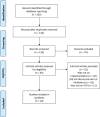Barriers and facilitators of videoconferencing psychotherapy implementation in veteran mental health care environments: a systematic review
- PMID: 33131495
- PMCID: PMC7603749
- DOI: 10.1186/s12913-020-05858-3
Barriers and facilitators of videoconferencing psychotherapy implementation in veteran mental health care environments: a systematic review
Abstract
Background: Whilst treatment for mental health issues has traditionally been conducted in-person, advances in technology has seen a recent growth in the use of online video therapy services to help overcome access-to-care barriers faced by those living in rural locations and those unable to travel. These barriers are particularly apparent in the case of veteran populations, which is the focus of this review. Whilst the research investigating the efficacy of online video therapy to treat mental health issues among veterans is promising, widespread adoption and utilisation of this modality remains low with efforts often failing to progress past the pilot phase to implementation. This review focuses on the implementation of online video therapy in veteran mental health care settings and aims to identify the potential barriers and facilitators relevant to implementing the modality in military organisations.
Methods: A systematic search of three databases (PsycInfo, PubMed, and Web of Science) was conducted. To be eligible for inclusion, studies had to investigate the challenges, lessons learnt, or factors operating as barriers and/or facilitators to the implementation of online video therapy in veteran health care systems.
Results: The initial search revealed a total of 202 articles. This was reduced to 133 when duplicates were removed. After screening the titles and abstracts a further 70 articles were excluded leaving 63 to be retrieved for full review. A total of 10 studies were included in this review. The most commonly reported barriers were related to clinician concerns, logistical problems, and technology. Other barriers included access to resources as well as challenges posed by collaborations, policy and recruitment. Facilitators included experience using the modality and having dedicated staff responsible for promoting and managing the new service (e.g., on-site champions and telehealth technicians).
Conclusions: This review suggests that numerous barriers must be identified and addressed before attempting to implement an online video therapy service in veteran organisations. Further research is needed to establish best practice for implementation, particularly across geographically dispersed sites. It is hoped that the findings of this review will be used to help inform future implementation efforts and research initiatives in this space.
Keywords: Implementation; Telemental health; Veterans; Videoconferencing.
Conflict of interest statement
The authors declare there are no competing interests.
Similar articles
-
Beyond the black stump: rapid reviews of health research issues affecting regional, rural and remote Australia.Med J Aust. 2020 Dec;213 Suppl 11:S3-S32.e1. doi: 10.5694/mja2.50881. Med J Aust. 2020. PMID: 33314144
-
Personalized implementation of video telehealth for rural veterans (PIVOT-R).Mhealth. 2021 Apr 20;7:24. doi: 10.21037/mhealth.2020.03.02. eCollection 2021. Mhealth. 2021. PMID: 33898593 Free PMC article.
-
Evaluation and Treatment of Mild Traumatic Brain Injury Through the Implementation of Clinical Video Telehealth: Provider Perspectives From the Veterans Health Administration.PM R. 2017 Mar;9(3):231-240. doi: 10.1016/j.pmrj.2016.07.002. Epub 2016 Jul 15. PM R. 2017. PMID: 27423365
-
Virtual Trauma-Focused Therapy for Military Members, Veterans, and Public Safety Personnel With Posttraumatic Stress Injury: Systematic Scoping Review.JMIR Mhealth Uhealth. 2020 Sep 21;8(9):e22079. doi: 10.2196/22079. JMIR Mhealth Uhealth. 2020. PMID: 32955456 Free PMC article.
-
Barriers and Facilitators That Influence Telemedicine-Based, Real-Time, Online Consultation at Patients' Homes: Systematic Literature Review.J Med Internet Res. 2020 Feb 20;22(2):e16407. doi: 10.2196/16407. J Med Internet Res. 2020. PMID: 32130131 Free PMC article.
Cited by
-
Features of Structured, One-to-One Videoconference Interventions That Actively Engage People in the Management of Their Chronic Conditions: Scoping Review.J Med Internet Res. 2025 Feb 26;27:e58543. doi: 10.2196/58543. J Med Internet Res. 2025. PMID: 40009439 Free PMC article.
-
eHealth and mHealth in Chronic Diseases-Identification of Barriers, Existing Solutions, and Promoters Based on a Survey of EU Stakeholders Involved in Regions4PerMed (H2020).J Pers Med. 2022 Mar 15;12(3):467. doi: 10.3390/jpm12030467. J Pers Med. 2022. PMID: 35330466 Free PMC article.
-
Adapting Group CBT-I for Telehealth-to-Home With Military Veterans in Primary Care.J Prim Care Community Health. 2023 Jan-Dec;14:21501319221143722. doi: 10.1177/21501319221143722. J Prim Care Community Health. 2023. PMID: 36625248 Free PMC article.
-
Results and Lessons Learned when Implementing Virtual Health Resource Centers to Increase Virtual Care Adoption During the COVID-19 Pandemic.J Technol Behav Sci. 2022;7(1):81-99. doi: 10.1007/s41347-021-00227-1. Epub 2021 Oct 25. J Technol Behav Sci. 2022. PMID: 34722860 Free PMC article.
-
Factors Influencing the Engagement with Electronic Mental Health Technologies: A Systematic Review of Reviews.Adm Policy Ment Health. 2025 Mar;52(2):415-427. doi: 10.1007/s10488-024-01420-z. Epub 2024 Oct 30. Adm Policy Ment Health. 2025. PMID: 39476280
References
-
- Jerome LW, Zaylor C. Cyberspace: creating a therapeutic environment for telehealth applications. Prof Psychol Res Pract. 2000;31(5):478. doi: 10.1037/0735-7028.31.5.478. - DOI
Publication types
MeSH terms
LinkOut - more resources
Full Text Sources
Medical
Miscellaneous


